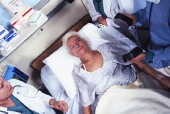
TUESDAY, March 5 (HealthDay News) — Experts estimate that many tens of thousands of people in the United States die each year from medical errors, unproven treatments, bad diagnoses and preventable problems such as bedsores. Now, a federal health care agency is urging the medical world to follow 10 strategies to improve safety for patients.
The strategies range from the straightforward — keep hands clean — to the complicated, including a series of measures to prevent pneumonia in people on ventilators. The agency also supports the use of checklists to prevent a variety of complications.
At first glance, the strategies seem fairly simple to implement because they mainly require changes in the protocol of treating patients. But it’s not an easy task, said Dr. Rainu Kaushal, director of the Center for Healthcare Informatics and Policy at Weill Cornell Medical College, in New York City.
“Practicing medicine is complex and growing increasingly complex every day. This includes even simple patient safety measures such as hand washing. Understanding when hand hygiene needs to be performed and in what manner is more complicated than remembering to wash one’s hands prior to eating,” said Kaushal, who’s familiar with the strategies listed in a report released Monday.
The report, from the U.S. Agency for Healthcare Research and Quality, was written by an international team of physicians and others who study medicine. The top 10 list of “Strongly Encouraged” strategies focuses on ways to prevent complications such as infections and blood clots.
A secondary list of “Encouraged” strategies addresses issues such as patient falls, bad drug interactions, radiation exposure and informed consent.
Here are some of the strategies from both lists:
- Better use of safety checklists around surgery and anesthesia use
- For patients on ventilators: “sedation vacations,” better mouth care, and suctioning to prevent pneumonia
- Hand-washing
- Bedsore-prevention measures
- Checklists to prevent bloodstream infections from central intravenous (IV) catheters in the large neck or heart veins
- Real-time ultrasounds when inserting central lines
- Reduced use of urinary catheters
- A “do not use” list of hazardous abbreviations
- Barrier precautions such as face masks, gloves, gowns used by health care providers to prevent spread of infection
- Measures to prevent patient falls
- Use of advance directives/living wills
- Lower-dose radiation from CT scans and other imaging tests
- Use of electronic medical orders
This isn’t the first time there’s been a major focus on errors that kill or sicken patients. In 1999, a landmark Institute of Medicine report estimated that as many as 98,000 patients in the United States die each year in hospitals and other facilities because of medical errors.
So what’s changed since then? Are fewer people dying?
“If you look at the global numbers, we haven’t made a lot of progress,” said report lead author Dr. Paul Shekelle, chief of internal medicine at VA West Los Angeles Medical Center and director of RAND’s Southern California Evidence-based Practice Center.
Indeed, a 2010 New England Journal of Medicine study that analyzed North Carolina hospitals from 2002 to 2007 found little change in patient safety, with many patients harmed or even killed by their treatment.
But, Shekelle said, there’s been progress in specific areas, such as preventing bloodstream infections from catheters. “We always want things to go faster than they do,” he said. “It was only 1999 when the very concept of patient safety was recognized as being of importance, and we’ve come a long way in 13 to 14 years.”
Now, Shekelle said, it’s clear how to prevent many medical mishaps. And it’s not a matter of just applying common sense, he said: Strong leadership is needed, and in some cases, like injuries from falls, “you’ve got to change the attitude that everybody falls, and there’s nothing you can do about it.”
Will it be costly to embrace these strategies? Kaushal said they’re cheaper than adopting other ways of improving safety, like new technology. And better patient safety saves money over time by decreasing time in the hospital, among other things, she added.
“Technology is a powerful way to systematically change practices, but those included in this list are generally behavioral and/or staffing practices, which are more prone to variation and require leadership to implement change,” Kaushal explained.
The report appears in the March 5 issue of Annals of Internal Medicine.
More information
For more about patient safety, visit the U.S. National Library of Medicine.

